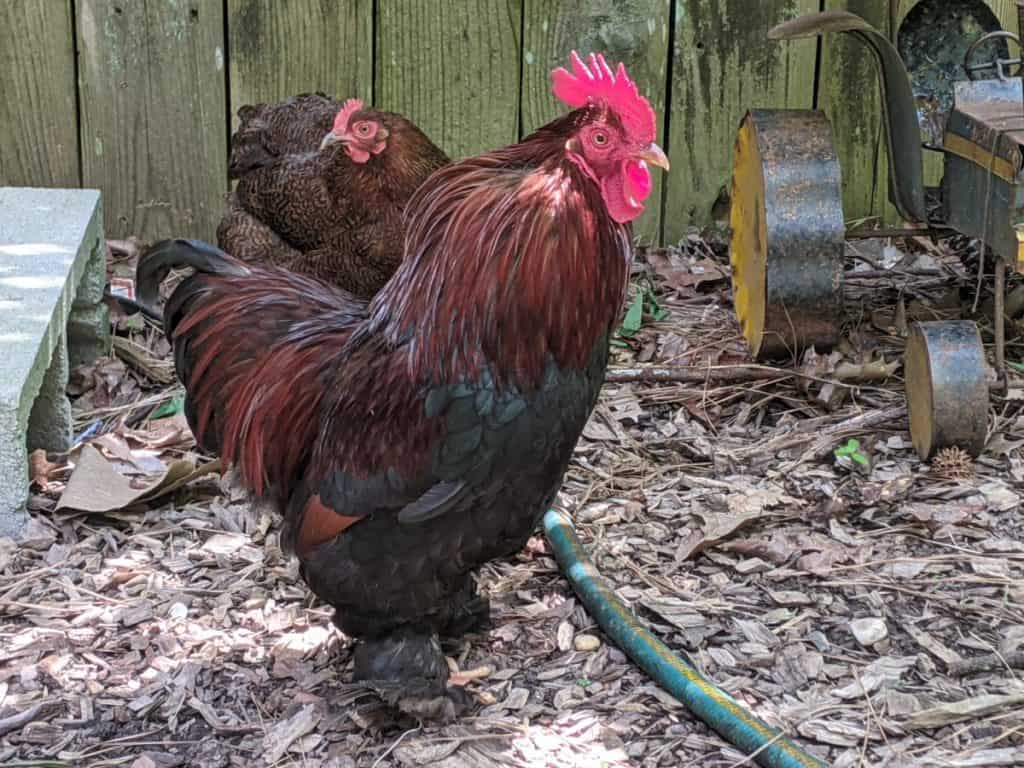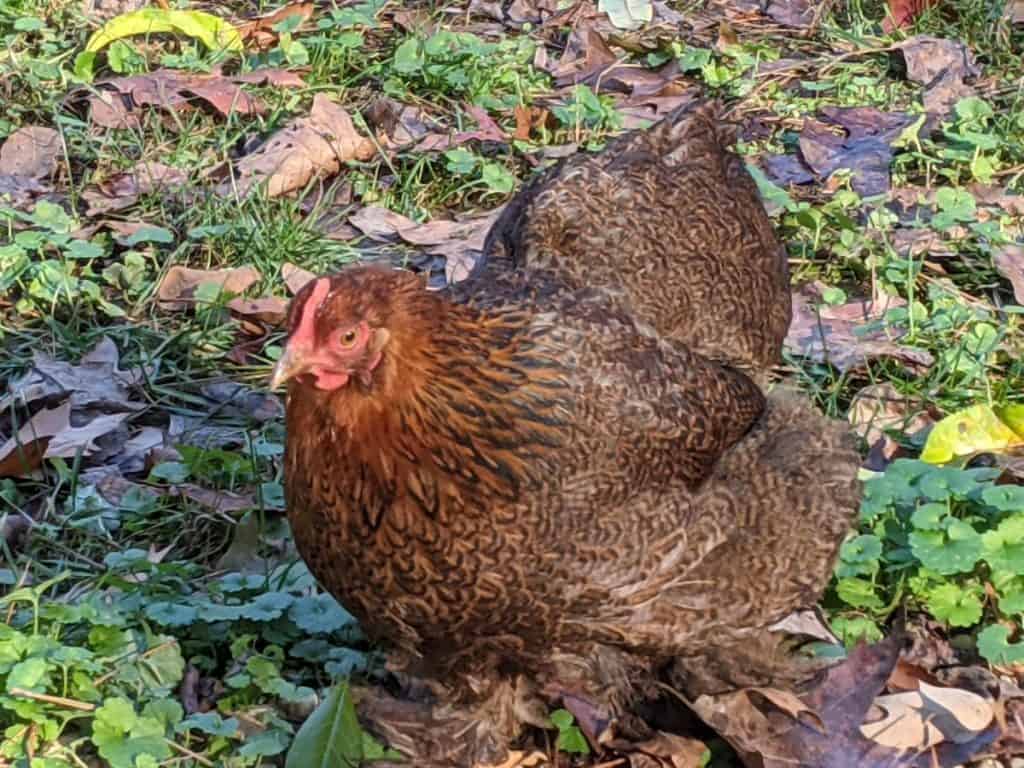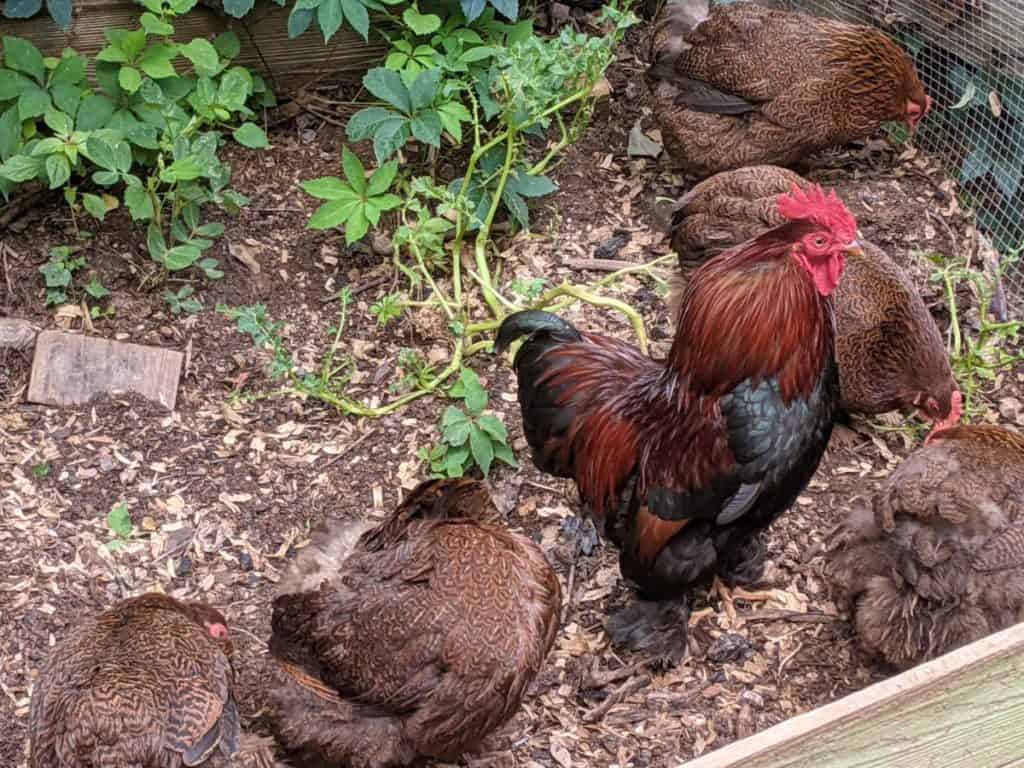It may seem like there is an apparent difference between a hen and a rooster; however, it can also be tricky to distinguish between the two, especially when they are young I have found.
As they get older and their feathers and features start to develop, it is easier to spot the difference between the two. So, how do you tell the difference between a hen and a rooster?
Hens have rounded feathers along their necks, and roosters have pointed feathers. A rooster has a long-curved tail, and its combs and wattles are more prominent than that of a hen’s. A rooster generally has more vibrant colors than his hen counterpart.
There are many more differences between a hen and a rooster, and this article will distinguish between all of them. You will never have to wonder what the difference is again; you will know!

What is a rooster?
A rooster, aka cockerel, aka cock is a male “gallinaceous bird.” The name originates from the US, whereas the names “cockerel” and “cock” originate from Ireland and the UK. When we hear the term “rooster,” we usually think of a male chicken, but a rooster is also referred to as grouse, pheasant, quail, partridge, and turkey males.
Roosters are polygamous animals, meaning they are not monogamous like penguins that only have one partner for life but have multiple partners.
They guard the hen’s nests, are incredibly territorial (especially towards other roosters), and are generally very protective animals.
A rooster is a lookout for the rest of his group and sits on a high perch most of the day, looking out for predators and danger. Though we are all familiar with a rooster crowing in the early hours of the morning, they crow during the day as well.

What Is A Hen?
A hen is a female “gallinaceous bird.” The name originates from the name “hannjo,” which is West Germanic and changed into “henn” in Old English and finally into the term “hen” that we are all familiar with today. A young hen is called a “pullet.”
Hens are the egg-layers of the two and make excellent mothers. They cackle while they are laying their eggs, and once the chicks have hatched, they use unique sounds to lure her chicks closer to her.
A hen does not crow like a rooster. They are considered warm, social birds amongst the flock, unlike their aloof rooster counterparts.
How To Spot The Differences Between A Hen And A Rooster
If you know the sex of your chickens, you can create a suitable living environment for the entire flock. Although not a straightforward procedure to find out if you have male or female chicks, there are some tried and trusted ways to go about doing so.
When your chicks hatch, keep a close eye on them. Look at the rate their size increases. Roosters appear to grow much faster in physical size than hens, so you can use that as a basis and use other additional methods to determine the sex of your new flock.
There are a few sure signs that will show you if you have a rooster or a hen. These methods aren’t always foolproof, but they have been the best and most effective ways for chicken farmers to know if they will have crowers or egg-layers.
5 Days Old Chick
There is no line on the outside corner of a rooster chick’s eye, whereas a hen has a visible dark brown line on either side of her eyes.
3 Weeks Old Chick
A rooster’s wattle and comb start to develop earlier than a hen. You can tell the difference in a rooster’s red or pink wattle and comb.
When a hen starts to develop a wattle and comb, it will be yellow instead of reddish-pink and not quite as prominent.
Reproductive Organs of Chickens
The reproductive organs of a hen and a rooster are located on the inside of their bodies and completely covered in feathers. This makes it very tricky to determine whether they are male or female.
Feather Sexing Chickens
This is the most widely used method to determine the sex of a chicken. Using this technique is only effective at 2-3 days after hatching.
If there is a rapid growth in feathers, it indicates that it is a female (a hen), and slow feather development indicates that it is a male (rooster).
Vent Sexing Chickens
This is a delicate procedure to perform to find out the sex of a chick. If you have not done it before, you could damage the chicken’s vent if you are not careful.
Here, you will have to hold the chick upside down in one hand, expelling the fecal material and turning the vent area outward. If there is a bump present, it is a male (rooster), and if there is no bump, you have a female (a hen).
This technique takes a lot of practice, so it would be best to consult an avian veterinarian to teach you how to perform vent sexing correctly.
Color Sexing Chickens
You won’t always be able to tell the sex of all the chicken species by looking at the color of their feathers when they are chicks. However, some breeds indicate immediately whether you have a male or female chicken.
For example, a New Hampshire and Rhode Island Red Breed’s feather color (after hatching) can determine if it is female or male. If it is a rooster, you will spot a white dot on the down feathers over the wing web. This spot will start to fade away or disappear once the rooster starts to grow adult feathers.
Differences Between A Hen And A Rooster – Summarized
| Hen | Rooster |
| Female Fowl | Male fowl |
| Short Tails | Tails are curved and long |
| Feathers are dull | Feathers are shiny |
| Feathers are rounded | Feathers are pointed |
| Hens only have two or three colors | Feathers are multi-colored |
| Thin legs | Thick legs |
| Less-pointy spurs | Strong, pointed spurs |
| Smaller wattles and combs – not as red or pink as a rooster’s. | Big, red wattles and combs |
| Chickens lay eggs | Roosters do not lay eggs |

In Conclusion
If you have no intention of farming with chickens for their eggs or meat, and you like to have them walking around in your backyard, you won’t really worry whether or not they are hens or roosters.
There are, however, chicken farmers whose lives depend on knowing. Ideally, a chicken farmer will always wish they hatch more hens than roosters because one rooster can make many hens lay many eggs.
If you have fewer hens and more roosters, there is more bullying, less egg production, and the harmony amongst your flock can fly out the window. Therefore, you need to be able to tell the difference between a rooster and a hen.

